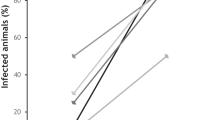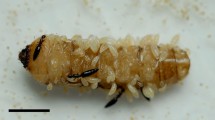Summary
Contrary to the expectations of kin selection theory, intracolony relatedness in eusocial insects is often low. We examined the idea that associations of low relatedness (high genetic variability) may be advantageous because of negative frequency-dependent selection on common host phenotypes by rapidly evolving parasites and pathogens. Using the natural host-parasite system of the bumble bee Bombus terrestris and its intestinal trypanosome Crithidia bombi, we investigated the transmission properties of parasites in host groups. Within naturally infested nests and in artificially constructed groups of workers, prevalence of infestation increased with time of exposure (Table 1). The susceptibility of isolated groups of workers to the parasites to which they were exposed differed with identity and natural infestation of their nest of origin (Table 2). In addition, those workers that were related to the individual introducing an infection to their group were more likely to become infested than were unrelated workers (Table 3). Although the bumble bee workers in experimental boxes appeared to differ in behavior toward kin and non-kin, making more physical contacts with kin, we found no discernible relationship between number of physical contacts and prevalence of infestation in a group. Therefore, we conclude that differences in parasite transmission reflected interactions among different host and parasite phenotypes. This system thus demonstrates the factors necessary for negative frequency-dependent selection by parasites on common host phenotypes - variability for susceptibility and infectiousness in host and parasite populations and similarity for these traits among related individuals. If, as we show here, high genetic relatedness within groups enhances parasite transmission, kin directed altruism may increase the risk of contracting parasites and infectious diseases. Therefore, parasites and pathogens may be an important force moderating the genetic structure of social groups.
Similar content being viewed by others
References
Alford DV (1975) Bumblebees. Davis-Poynter, London
Allard RW (1990) The genetics of host-pathogen coevolution: implications for genetic resource conservation. J Hered 81:1–6
Bartz SH, Holldobler B (1982) Colony founding in Myrmecocystus mimicus Wheeler (Hymenoptera: Formicidae) and the evolution of foundress associations. Behav Ecol Sociobiol 10:137–147
Bornais KM, Larch CM, Gamboa GJ, Daily RB (1983) Nestmate discrimination among laboratory overwintered foundresses of the paper wasp Polistes fuscatus. Can Entomol 115:655–658
Bremermann HJ (1980) Sex and polymorphism as strategies in host-pathogen interactions. J Theor Biol 87:671–702
Carlin NF (1988) The gyne who would be queen: dominance in the ant Iridomyrmex purpureus In: Jeanne RL (ed) Interindividual behavioral variability in social insects. Westview Press, Boulder London, pp 147–177
Cole BJ (1983) Multiple mating and the evolution of social behavior in the Hymenoptera. Behav Ecol Sociobiol 12:191–201
Craig R (1979) Parental manipulation, kin selection, and the evolution of altruism. Evolution 33:319–334
Crozier RH (1977) Evolutionary genetics of the Hymenoptera. Annu Rev Entomol 22:263–288
Crozier RH, Page RE (1985) On being the right size: male contributions and multiple mating in social Hymenoptera. Behav Ecol Sociobiol 18:105–215
Crozier RH, Smith BH, Crozier YC (1987) Relatedness and population structure of the primitively eusocial bee Lasioglossum zephyrum (Hymenoptera: Halictidae) in Kansas. Evolution 41:902–910
Ferguson MM, Drahushchak LR (1990) Diseases resistance and enzyme heterozygosity in rainbow trout. Heredity 64:413–417
Frumhoff PC, Baker J (1988) A genetic component to division of labour within honey bee colonies. Nature 333:358–361
Grafen A (1982) How not to measure inclusive fitness. Nature 298:425–426
Greenberg L (1979) Genetic component of bee odor in kin recognition. Science 206:1095–1097
Haldane JBS (1954) The statics of evolution. In: Huxley J, Hardy AC, Ford EB (eds) Evolution as a process. Allen & Unwin, London, pp 109–121
Hamilton WD (1964) The genetical evolution of social behaviour I, II. J Theor Biol 7:1–16, 17–52
Hamilton WD (1980) Sex versus non-sex versus parasite. Oikos 35:282–290
Hamilton WD (1987) Kinship, recognition, disease, and intelligence: constraints on social evolution. In: Itô Y, Brown JL, Kikkawa J (eds) Animal societies; theories and facts. Japanese Scientific Society Press, Tokyo, pp 81–102
Hamilton WD, Axelrod A, Tanese R (1990) Sexual reproduction as an adaptation to resist parasites (a review). Proc Natl Acad Sci USA 87:3566–3573
Herbers JM (1986) Nest site limitation and facultative polygyny in the ant Leptothorax longispinosis. Behav Ecol Sociobiol 19:115–122
Hölldobler B, Wilson EO (1977) The number of queens: an important trait in ant evolution. Naturwissenschaften 64:8–15
Hughes CR, Queller DC, Strassmann JE (1990) Relazedness in neo-tropical polygynous wasps. In: Veeresh GK, Mallik B, Viraktamath CA (eds) Social insects and the environment. Oxford & IBH Publishing, New Delhi Bombay Calcutta, pp 252–253
Laidlaw HH, Page RE (1984) Polyandry in honey bees (Apis mellifera L.): sperm utilization and intracolony genetic relationships. Genetics 108:985–997
Lipa JJ, Triggiani O (1980) Crithidia bombi sp. n. a flagelated parasite of a bumble-bee Bombus terrestris L. (Hymenoptera, Apidae). Acta Protozool 27:287–290]
Metcalf RA, Whitt GS (1977) Relative inclusive fitness in the social wasp Polistes metricus. Behav Ecol Sociobiol 2:353–360
Michener CD (1964) Reproductive efficiency in relation to colony size in hymenopterous societies. Insectes Soc 11: 317–341
Moritz RFA (1985) The effects of multiple mating on the worker-queen conflict in Apis mellifera. L. Behav Ecol Sociobiol 16:375–377
Nonacs P (1988) Queen number in colonies of social Hymenoptera as a kin-selected adaptation. Evolution 42:566–580
Noonan KC (1986) Recognition of queen larvae by worker honey bees Apis mellifera L. Ethology 73:295–306
Noonan KC, Kolmes SA (1989) Kin recognition of worker brood by worker honey bees, Apis mellifera L. J Insect Behav 2:473–485
Noonan KN (1981) Individual strategies of inclusive-fitness maximizing in Polistes fuscatus foundresses. In: Alexander RD, Tinkle DW (eds) Natural selection and social behavior: recent research and new theory. Chiron Press, New York, pp 18–44
Page RE (1980) The evolution of multiple mating behavior by honey bee queens (Apis mellifera L.). Genetics 96:263–273
Page RE, Erickson EH (1986) Kin recognition during emergency queen rearing by worker honey bees (Hymenoptera: Apidae). Ann Entomol Soc Am 79:460–467
Page RE, Robinson GE, Fondrk MK (1989) Genetic specialists, kin recognition, and nepotism in honey-bee colonies. Nature 338:576–579
Pamilo P, Crozier RH (1982) Measuring genetic relatedness in natural populations: methodology. Theor Popul Biol 21:171–193
Pearson B (1983) Intra-colonial relatedness amongst workers in a population of nests of the polygynous ant, Myrmica rubra Latreille. Behav Ecol Sociobiol 12:1–4
Post DC, Jeanne RL (1982) Recognition of former nestmates during colony founding by the social wasp Polistes fuscatus (Hymenoptera: Vespidae). Behav Ecol Sociobiol 11:283–285
Pratte M (1982) Relations anterieures at association de fondation chez Polistes gallicus L. Insectes Soc 29:352–357
Queller DC, Goodnight KF (1989) Estimating relatedness using genetic markers. Evolution 43:258–275
Queller DC, Strassmann JE (1987) Selection on group nesting in foundresses of Polistes annularis. In: Eder J, Rembold H (eds) Chemistry and biology of social insects. Peperny, Munich, pp 333–334
Queller DC, Strassmann JE (1988) Reproductive success and group nesting in the paper wasp Polistes annularis In: Clutton-Brock TH (ed) Reproductive success. University of Chicago Press, Chicago London, pp 76–96
Queller DC, Strassmann JE, Hughes CR (1988) Genetic relatedness in colonies of tropical wasps with multiple queens. Science 242:1155–1157
Queller DC, Hughes CR, Strassmann JE (1990) Wasps fail to make distinctions. Nature 344:388
Rissing SW, Pollock GB (1987) Queen aggression, pleometroic advantage and brood raiding in the ant Veromessor pergandei (Hymenoptera: Formicidae). Anim Behav 35:975–981
Rissing SW, Pollock GB (1988) Pleometrosis and polygyny in ants. In: Jeanne RL (ed) Interindividual behavioral variability in social insects. Westview Press, Boulder London, pp 179–222
Rissing SW, Pollock GB, Higgins MR, Hagen RH, Smith DR (1989) Foraging specialization without relatedness or dominance among co-founding ant queens. Nature 338:420–422
Robinson GE, Page RE (1988) Genetic determination of guarding and undertaking in honey-bee colonies. Nature 333:356–358
Röseler P-F (1973) Die Anzahl Spermien im Receptaculum seminis von Hummelköniginnem (Hymenoptera, Apidae, Bombinae). Apidologie 4:267–274
Ross NM, Gamboa GJ (1981) Nestmate discrimination in social wasps (Polistes metricus, Hymenoptera: Vespidae). Behav Ecol Sociobiol 3:163–165
SAS Institute (1985) Statistics, version 5. SAS Institute, Cary NC
Schmid-Hempel P, Müller C, Schmid-Hempel R, Shykoff JA (1990) Frequency and ecological correlates of parasitism by conopid flies (Conopidae, Diptera) in populations of bumblebees. Insectes Soc 37:14–30
Schwarz MP (1986) Persistent multi-female nests in an Australian allodapine bee, Exoneura bicolor (Hymenoptera, Anthophoridae). Insectes Soc 33:258–277
Sherman PW, Seeley TD, Reeve HK (1988) Parasites, pathogens, and polyandry in social Hymenoptera. Am Nat 131:602–610
Shykoff JA, Schmid-Hempel P (1991) Incidence and effects of four parasites in natural populations of bumble bees in Switzerland. Apidologie (in press)
Strassmann JE (1989) Altruism and relatedness at colony foundation in social insects. TREE 4:371–374
Strassmann JE, Hughes CR, Queller DC, Turillazzi S, Cervo R, Davis SK, Goodnight KJ (1989) Genetic relatedness in primitively eusocial wasps. Nature 342:268–270
Tooby J (1982) Pathogens, polymorphism, and the evolution of sex. J Theor Biol 97:557–576
Visscher PK (1986) Kinship discrimination in queen rearing by honey bees (Apis mellifera). Behav Ecol Sociobiol 18:453–460
West-Eberhard MJ (1982) The nature and evolution of swarming in tropical social wasps. In: Jaisson P (ed) Social insects in the tropics. University Paris-Nord, Paris, pp 97–128
Wilson EO (1971) The insect societies. Harvard University Press, Cambridge MA
Zar JH (1984) Biostatistical analysis, 2nd edn. Prentice-Hall, Engelwood Cliffs NJ
Author information
Authors and Affiliations
Additional information
Offprint requests to: J.A. Shykoff at the present address
Rights and permissions
About this article
Cite this article
Shykoff, J.A., Schmid-Hempel, P. Genetic relatedness and eusociality: parasite-mediated selection on the genetic composition of groups. Behav Ecol Sociobiol 28, 371–376 (1991). https://doi.org/10.1007/BF00164387
Received:
Accepted:
Issue Date:
DOI: https://doi.org/10.1007/BF00164387




